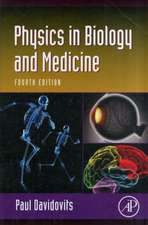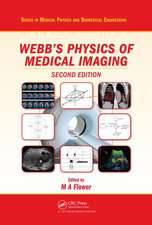Electron Correlations in Molecules and Solids: Springer Series in Solid-State Sciences, cartea 100
Autor Peter Fuldeen Limba Engleză Paperback – 9 oct 1995
Din seria Springer Series in Solid-State Sciences
- 18%
 Preț: 1225.94 lei
Preț: 1225.94 lei - 18%
 Preț: 1017.62 lei
Preț: 1017.62 lei - 15%
 Preț: 532.05 lei
Preț: 532.05 lei - 18%
 Preț: 944.51 lei
Preț: 944.51 lei -
 Preț: 541.47 lei
Preț: 541.47 lei - 18%
 Preț: 956.96 lei
Preț: 956.96 lei -
 Preț: 385.84 lei
Preț: 385.84 lei - 15%
 Preț: 661.02 lei
Preț: 661.02 lei -
 Preț: 389.88 lei
Preț: 389.88 lei - 15%
 Preț: 639.59 lei
Preț: 639.59 lei - 15%
 Preț: 635.15 lei
Preț: 635.15 lei - 18%
 Preț: 896.21 lei
Preț: 896.21 lei - 15%
 Preț: 647.92 lei
Preț: 647.92 lei - 15%
 Preț: 651.34 lei
Preț: 651.34 lei - 18%
 Preț: 890.23 lei
Preț: 890.23 lei - 15%
 Preț: 640.55 lei
Preț: 640.55 lei - 15%
 Preț: 649.54 lei
Preț: 649.54 lei - 15%
 Preț: 645.60 lei
Preț: 645.60 lei - 15%
 Preț: 644.30 lei
Preț: 644.30 lei - 15%
 Preț: 653.79 lei
Preț: 653.79 lei - 18%
 Preț: 956.69 lei
Preț: 956.69 lei - 15%
 Preț: 637.59 lei
Preț: 637.59 lei - 23%
 Preț: 1043.42 lei
Preț: 1043.42 lei - 15%
 Preț: 639.08 lei
Preț: 639.08 lei - 15%
 Preț: 648.24 lei
Preț: 648.24 lei - 15%
 Preț: 637.46 lei
Preț: 637.46 lei - 15%
 Preț: 640.06 lei
Preț: 640.06 lei -
 Preț: 391.40 lei
Preț: 391.40 lei -
 Preț: 390.84 lei
Preț: 390.84 lei - 15%
 Preț: 638.57 lei
Preț: 638.57 lei - 18%
 Preț: 1006.06 lei
Preț: 1006.06 lei - 18%
 Preț: 730.79 lei
Preț: 730.79 lei - 15%
 Preț: 640.37 lei
Preț: 640.37 lei - 15%
 Preț: 643.65 lei
Preț: 643.65 lei - 18%
 Preț: 1231.01 lei
Preț: 1231.01 lei - 18%
 Preț: 950.21 lei
Preț: 950.21 lei - 15%
 Preț: 642.68 lei
Preț: 642.68 lei - 15%
 Preț: 640.55 lei
Preț: 640.55 lei - 18%
 Preț: 1229.10 lei
Preț: 1229.10 lei
Preț: 1827.48 lei
Preț vechi: 2228.64 lei
-18% Nou
Puncte Express: 2741
Preț estimativ în valută:
349.74€ • 363.78$ • 288.72£
349.74€ • 363.78$ • 288.72£
Carte tipărită la comandă
Livrare economică 15-29 aprilie
Preluare comenzi: 021 569.72.76
Specificații
ISBN-13: 9783540593645
ISBN-10: 3540593640
Pagini: 500
Ilustrații: XIV, 483 p. 7 illus.
Dimensiuni: 155 x 235 x 26 mm
Greutate: 0.75 kg
Ediția:3rd enlarged ed. 1995
Editura: Springer Berlin, Heidelberg
Colecția Springer
Seria Springer Series in Solid-State Sciences
Locul publicării:Berlin, Heidelberg, Germany
ISBN-10: 3540593640
Pagini: 500
Ilustrații: XIV, 483 p. 7 illus.
Dimensiuni: 155 x 235 x 26 mm
Greutate: 0.75 kg
Ediția:3rd enlarged ed. 1995
Editura: Springer Berlin, Heidelberg
Colecția Springer
Seria Springer Series in Solid-State Sciences
Locul publicării:Berlin, Heidelberg, Germany
Public țintă
Professional/practitionerCuprins
1. Introduction.- 2. The Independent-Electron Approximation.- 2.1 Starting Hamiltonian.- 2.2 Basis Functions and Basis Sets.- 2.3 Self-Consistent Field Approximation.- 2.4 Simplified SCF Calculational Schemes.- 2.5 Koopmans’ Theorem.- 2.6 Homogeneous Electron Gas.- 2.7 Local Exchange Potential — The Xa Method.- 2.8 Shortcomings of the Independent-Electron Approximation.- 2.9 Unrestricted SCF Approximation.- 3. Density Functional Theory.- 3.1 Thomas-Fermi Method.- 3.2 Hohenberg-Kohn-Sham Theory.- 3.3 Local-Density Approximation.- 3.4 Results for Atoms, Molecules, and Solids.- 3.5 Extensions and Limitations.- 4. Quantum-Chemical Approach to Electron Correlations.- 4.1 Configuration Interactions.- 4.2 Many-Body Perturbation Theory.- 5. Cumulants, Partitioning, and Projections.- 5.1 Cumulant Representation.- 5.2 Projection and Partitioning Techniques.- 5.3 Coupled-Cluster Method.- 5.4 Comparison with Various Trial Wavefunctions.- 5.5 Simplified Correlation Calculations.- 6. Excited States.- 6.1 CI Calculations and Basis Set Requirements.- 6.2 Excitation Energies in Terms of Cumulants.- 6.3 Green’s Function Method.- 6.4 Local Operators.- 7. Finite-Temperature Techniques.- 7.1 Approximations for Thermodynamic Quantities.- 7.2 Functional-Integral Method.- 7.3 Monte Carlo Methods.- 8. Correlations in Atoms and Molecules.- 8.1 Atoms.- 8.2 Hydrocarbon Molecules.- 8.3 Molecules Consisting of First-Row Atoms.- 8.4 Strength of Correlations in Different Bonds.- 8.5 Polymers.- 8.6 Photoionization Spectra.- 9. Semiconductors and Insulators.- 9.1 Ground-State Correlations.- 9.2 Excited States.- 10. Homogeneous Metallic Systems.- 10.1 Fermi-Liquid Approach.- 10.2 Charge Screening and the Random-Phase Approximation.- 10.3 Spin Fluctuations.- 11. Transition Metals.- 11.1 CorrelatedGround State.- 11.2 Excited States.- 11.3 Finite Temperatures.- 12. Strongly Correlated Electrons.- 12.1 Molecules.- 12.2 Anderson Hamiltonian.- 12.3 Effective Exchange Hamiltonian.- 12.4 Magnetic Impurity in a Lattice of Strongly Correlated Electrons.- 12.5 Hubbard Hamiltonian.- 12.6 The t — J Model.- 12.7 Slave Bosons in the Mean-Field Approximation.- 12.8 Kanamori’s t-Matrix Approach.- 13. Heavy-Fermion Systems.- 13.1 The Fermi Surface and Quasiparticle Excitations.- 13.2 Model Hamiltonian and Slave Bosons.- 13.3 Application of the Noncrossing Approximation.- 13.4 Variational Wavefunctions.- 13.5 Quasiparticle Interactions.- 13.6 Quasiparticle-Phonon Interactions Based on Strong Correlations.- 14. Superconductivity and the High-Tc Materials.- 14.1 The Superconducting State.- 14.2 Electronic Properties of the High-Tc Materials.- 14.3 Other Properties of the Cuprates.- 14.4 Heavy Fermions in Nd2_xCexCuO4.- B. Derivation of Several Relations Involving Cumulants.- C. Projection Method of Mori and Zwanzig.- D. Cross-Over from Weak to Strong Correlations.- E. Derivation of a General Form for ??).- F. Hund’s Rule Correlations.- G. Cumulant Representation of Expectation Values and Correlation Functions.- H. Diagrammatic Representation of Certain Expectation Values.- I. Derivation of the Quasiparticle Equation.- J. Coherent-Potential Approximation.- K. Derivation of the NCA Equations.- L. Ground-State Energy of a Heisenberg Antiferromagnet on a Square Lattice.- M. The Lanczos Method.- References.
Textul de pe ultima copertă
Electron Correlations in Molecules and Solids bridges the gap between quantum chemistry and solid-state theory. In the first half of the text new concepts are developed for treating many-body and correlation effects, combining standard quantum chemical methods with projection techniques, Greens-function methods and Monto-Carlo techniques. The second half deals with applications of the theory to molecules, semiconductors, transition metals, heavy fermion systems, and the new high-Tc superconducting materials.











